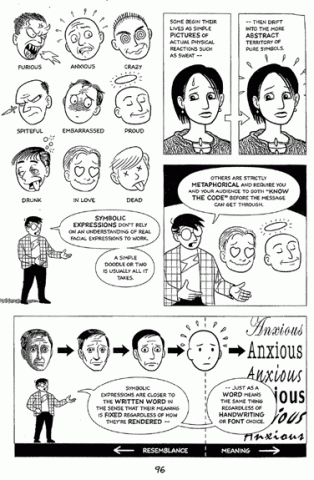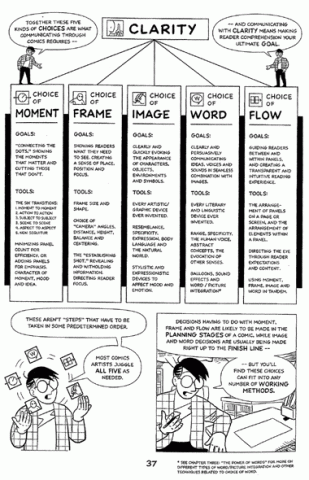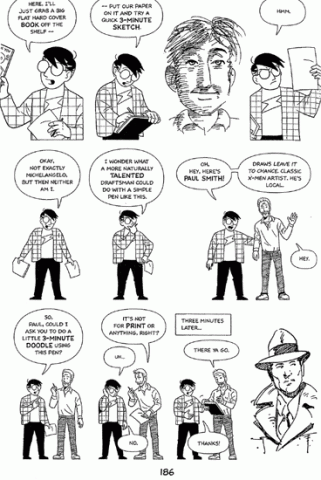Review of Scott McCloud, Making Comics: Storytelling Secrets of Comics, Manga and Graphic Novels (Harper Paperbacks, 2006)
Ben McCorkle, Ohio State University at Marion
Enculturation 7 (2010): http://enculturation.net/a-rhetoric-of-sequential-art
Compositionists have long held an interest in visual culture, as textbooks such as Seeing & Writing, Convergences, and Rhetorical Visions demonstrate, not to mention recent scholarly books such as Carolyn Handa’s Visual Rhetoric in a Digital World or Kristie Fleckenstein’s Vision, Rhetoric, and Social Action in the Composition Classroom. Books in this vein expand our critical perspective of what counts as a worthwhile cultural artifact, moving beyond the confines of high art and into the sometimes maligned world of advertisements, graffiti, and even (perish the thought) comics. For the most part, such efforts tend to focus more on the analysis and critique of preexisting visual texts and less on how students themselves might produce such texts. It is within this context that we can read Scott McCloud’s book Making Comics: Storytelling Secrets of Comics, Manga, and Graphic Novels. We can read McCloud’s text as a rhetoric of comics in that it not only offers readers practical and theoretical advice for producing aesthetically effective and engaging comics of their own, it also demonstrates its own argument in a sophisticated yet visually appealing manner.

Figure 1: Making Comics, p. 96
Making Comics is the third book by comics artist McCloud and arguably his most practice-oriented one. In 1993, McCloud gave us the theoretically insightful (and whimsically illustrated) Understanding Comics, which received almost unanimous praise and gave academics an analytical footing from which to study comics and the graphic novel. In 2000, McCloud released Reinventing Comics, a follow-up work that upset many of his former fans because of its provocative, manifesto-like argument. McCloud called for a radical restructuring of the form of comics as well as the industry’s professional demographics (critic Gary Goth even penned a dismantling of the book entitled "McCloud's Cuckoo-Land"). In 2006, McCloud returns to form with Making Comics, a work that offers readers and practitioners of comics alike a rhetorical handbook for an art form that is finally getting the kind of serious academic attention that it deserves.
Making Comics offers readers a rather thorough overview of the entire universe of comics illustration, examining not only comic books and the graphic novel, but also manga, daily comic strips, and single-panel cartoons. McCloud's overriding purpose is to present the reader with a range of possible choices for the various elements of comics writing, such as panel placement, lettering styles, what action to capture, and which words to use. More than simply delineating these options, however (and the reason that I refer to the book as a rhetoric of comics), he also articulates why someone might likely make certain choices over others to enhance dramatic effect, promote ambiguity, or develop identification with characters. In other words, the book delves into long-standing rhetorical issues such as ascertaining audience expectations and generic conventions, defining an explicit purpose for one’s text, and developing an appropriate tone or affect for delivery. This attention to the craft (from the storyboarding stage to the design of characters, to the development of settings, and down to inking and coloring) elevates this book above a whole slew of related how-to books clogging the racks at your local comics store, which focus primarily on refining illustration techniques and developing styles.

Figure 2: Making Comics, p. 37
In his recognizable comic-book-styled format (mostly black and white, cartoonish, with bold line work), McCloud proceeds to explain to the reader the vast array of technical, artistic, and rhetorical tools available to authors and artists. He begins by specifying the rhetorical fundamentals of the craft, or what he refers to as the "five choices": moment, frame, image, word, and flow. As McCloud explains it, these fundamental sets of choices create the building blocks for constructing compelling narratives with which audiences will readily identify. From there, he discusses how to convey emotional, physical, and narrative information to the reader by examining the complexities of drawing facial expressions, bodily posture and gestures, and other attributes of body language. He even goes so far as to point out the underlying physical anatomy of the human face and body, and he creates rather detailed charts of facial expressions such as fear, joy, surprise, or anger (these disembodied faces, while certainly explanatory, are easily the single creepiest part of the book). He then explains the importance of alphabetical components in comic art, describing the different ways that words and images interact with each other, how words can communicate graphically via different lettering styles, and various ways of portraying sound effects via onomatopoeia. McCloud's attention to these textual matters is an attempt on his part to enrich his readers' understanding of what is commonly misunderstood as primarily a graphical art form. McCloud then devotes a chapter to the importance of developing detailed, purposeful worlds that characters inhabit, worlds that contribute to and affect the storyline rather than existing as a passive backdrop for the action. In each of these sections, McCloud writes/draws in the typically graspable, cogent style he is known for.
From a writing teacher’s perspective, I can see value in McCloud’s discussion of the five choices in a couple of scenarios. Certainly, those adventurous teachers who actually assign comic-based projects will find this information of immediate and clear value. Additionally, those teachers dealing with more traditional writing assignments in a visually themed course might well find this section useful for illustrating related writing concepts: adding detail to scenes (frame), deciding when to paraphrase or quote someone directly (word), or how to create compelling sense of pacing in narrative (flow), for example. Essentially, McCloud’s text can be used to make the familiar strange—to analogously recast how students think about composing—and can provide teachers with stronger, more effective conceptual models.

Figure 3: Making Comics, p. 186
After a clear explanation of how to achieve strong illustrating technique and storytelling skills, McCloud pulls back from the action occurring within the frame and instead shifts to a discussion of "real world" issues that affect the burgeoning comics amateur. He offers the reader practical advice on the types of tools available for him or her, from low-cost felt markers and drafting tables to more costly computer software, graphics tablets, and related digital tools. Always thinking practically, McCloud dissects some of his own drawings, showing how they were created in Photoshop by combining several layers of digital and hand-drawn images, specially designed fonts, and colored elements. Usually even-handed in tone, McCloud doesn't advocate certain approaches or styles over others, and he often samples from and solicits the advice of other artists to provide readers with different perspectives about tools, techniques, and the business of publishing. McCloud is careful to frame his subject not as a series of codified, iron-clad rules, but rather as evolving conventions driven by its practitioners. These conventions are subject to change depending upon the outcome of professional and popular conversations. Such moves help McCloud unpack a larger discursive context for the practice of composing comics. Far from seeming dogmatic about professionalization, McCloud seems more interested in persuading readers to consider taking up comics either as vocation or avocation, a move ultimately concerned with the long-term sustainability of the medium.
One particularly useful feature of this book, which extends its practical, pedagogical focus, is the inclusion of optional assignments at the end of each chapter. These assignments are meant to reinforce the ideas presented in the preceding chapter, and so they deal with issues that go beyond just developing drawing techniques. For example, one exercise asks the reader to record someone speaking and then to recreate the intonation and character of that speech using only letters. Many other assignments are critical reading exercises, asking the reader to locate certain elements in existing comics (framing, character modeling, etc.), assess their effectiveness, and suggest ways of improving upon the originals. Such assignments are designed to emphasize the range of rhetorical choices available to the artist, and I imagine they could easily be adapted for a course dealing with the production of comics and related visual texts.
It should be noted that Making Comics is not entirely oriented toward practice. In the later chapters, McCloud delves into such theoretical territory as genre analysis of the various types of comics out on the market (superhero, realist, erotic, manga, and so on), dissecting their common traits, story lines, and aesthetics along the way. He also presents his own theoretical schema for the various camps of illustrators, based in large part on Jungian theory: classicists, animists, formalists, and iconoclasts. While such an approach to defining such groups might risk becoming hackneyed or antiquated, McCloud is careful to embrace the nuances of his structure, admitting that the boundaries between the groups are fluid and dynamic and that individuals often exhibit characteristics of more than one camp. Such moves seem as if they are meant to further the theoretical savvy of budding artists as they consider how to hone their skills before entering the profession; in fact, the very last portion of the book is an exhortation to the reader to pick up pen and ink (or an equivalent digital toolkit) and enter the fray, an encouraging note on which to end.
As rhetoric and composition becomes more firmly entrenched in the study of visual culture, new media forms, and multimodal production, it is important that we look to works outside of our field that offer both analytical and heuristic perspectives from within the profession. Making Comics is such a work because it deftly devotes its energies to explaining the various forms, genres, techniques, and prevailing philosophies of the world of comics illustration, both as a matter of practice and as a matter of theory. As such, it seems highly useful in classes that might look to comics and related art forms as objects for consumption as well as production. On the strength of that versatility, McCloud's latest work deserves at least as much of our attention as we have given his ground-breaking salvo Understanding Comics.
Works Cited
Atwan, Robert. Convergences: Themes, Texts, and Images for Composition. 3rd ed. New York: Bedford/St. Martin’s P, 2008. Print.
Fleckenstein, Kristie. Vision, Rhetoric, and Social Action in the Composition Classroom Carbondale: Southern Illinois UP, 2010. Print.
Handa, Carolyn. Visual Rhetoric in a Digital World: A Critical Sourcebook. New York: Bedford/St. Martin’s P, 2004. Print.
Hesford, Wendy S. and Brenda Brueggemann, eds. Rhetorical Visions: Reading and Writing in a Visual Culture. New York: Prentice Hall, 2006. Print.
McCloud, Scott. Making Comics: Storytelling Secrets of Comics, Manga, and Graphic Novels. New York: Harper, 2006. Print.
McQuade, Donald and Christine McQuade, eds. Seeing & Writing. 4th ed. New York: Bedford/St. Martin’s P, 2010. Print.